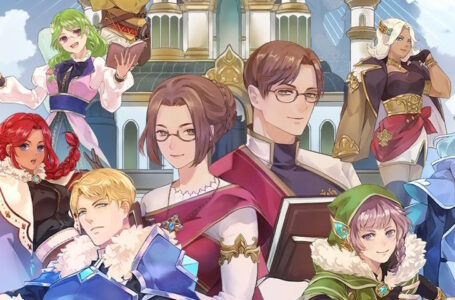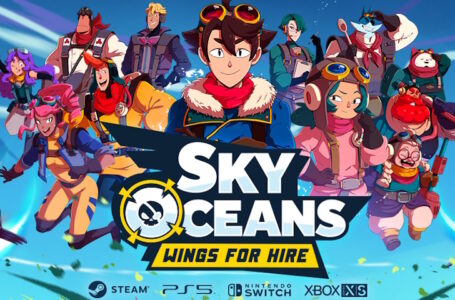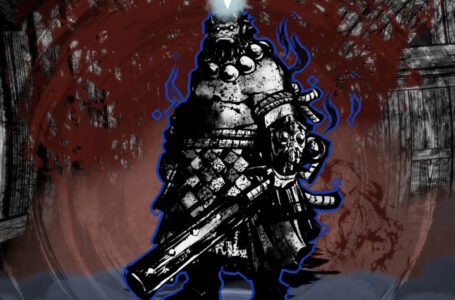Hands-on with Blue Reflection: Second Light – yep, this is going to be special
We love a bit of Blue Reflection here at Rice Digital, and it’s fair to say that the upcoming sequel is one of our most anticipated games of 2021. So when Koei Tecmo offered us an opportunity to play the early hours of the game and see how it all works, we of course jumped at the opportunity. And I’m pleased to report that things are looking very good indeed ahead of the game’s launch on November 9, 2021.
In Blue Reflection: Second Light, you take on the role of Ao Hoshizaki, a young girl who has found herself whisked away to another world. Said other world appears to consist of nothing more than a school that is surrounded by water on all sides, and an entrance to a mysterious land that the main cast come to refer to as “The Faraway”.
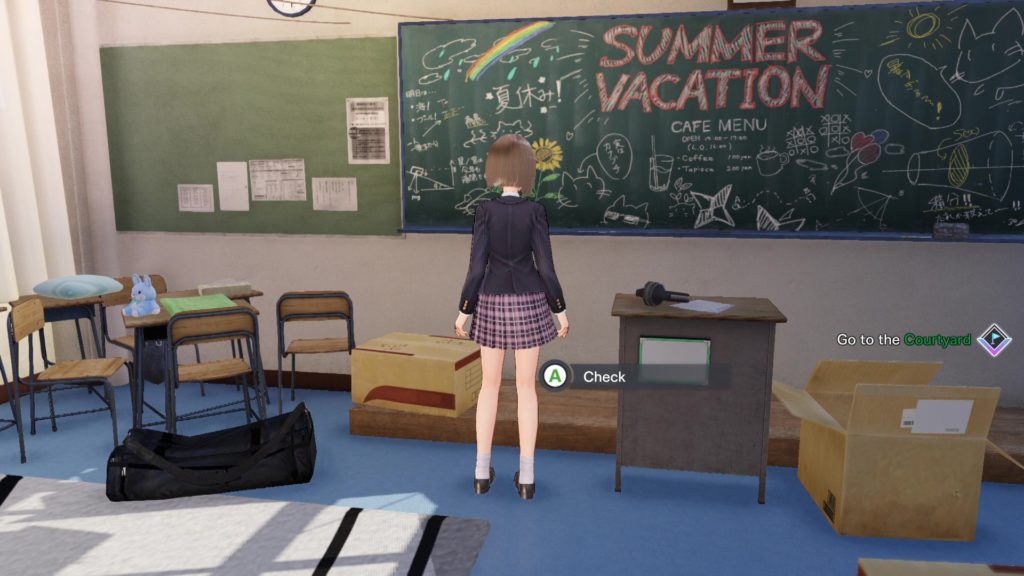
Longstanding series fans will doubtless notice that the school bears an uncanny resemblance to the school from the original game, though with how far we played it remains to be seen if it really is the same one, just an image thereof or something else altogether. Given that promotional materials have made no secret of the fact that Hinako, heroine of the first Blue Reflection, shows up later in the game, it’s entirely possible that it’s the same school, and that something strange has happened to it.
And it is strange; the school is completely deserted aside from Ao, three girls named Kokoro, Rena and Yuki who have apparently been living in this other world for quite some time, and a mysterious girl named Yuko who has a habit of showing up, saying something odd and then disappearing somewhere unknown.
Kokoro, Rena and Yuki have all lost most of their memories; they can remember their names and the basics of how to live and function, but nothing about their past lives or what they presumably left behind when they were brought to this strange other world.
A key part of Blue Reflection: Second Light’s overall progression involves discovering the memories of the girls and piecing together their stories — it’s a twist on how the original game involved tracking down emotional “Fragments” and demonstrating empathy towards them in order to help the game’s cast come to terms with various things in their life.
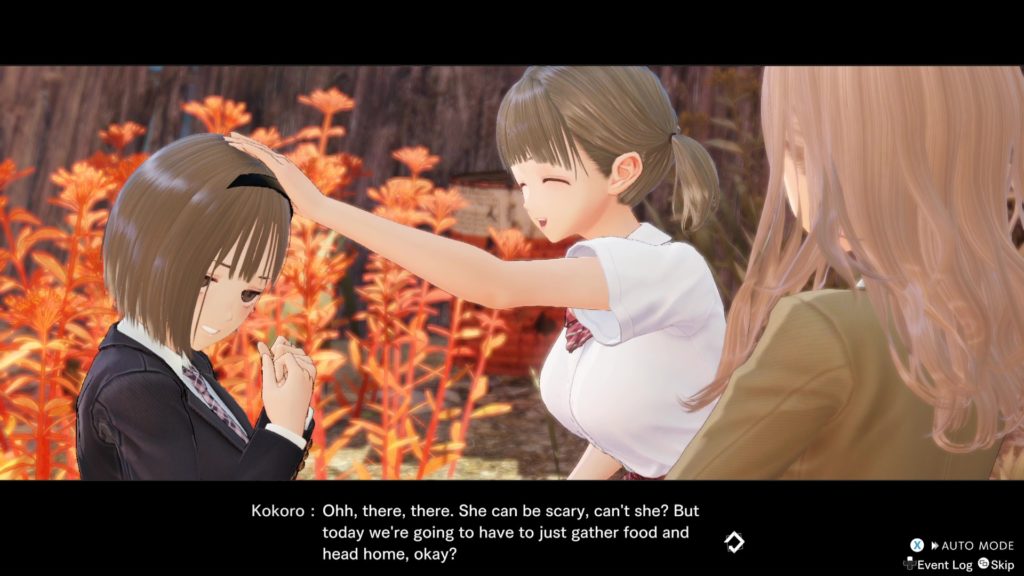
The early hours of Blue Reflection: Second Light introduce you to how the game works with some helpful tutorials incorporated into the unfolding story. By the time the game’s anime-style opening video finally plays a couple of hours into the experience, you’ll have encountered most of the game’s major mechanics in their most basic form — though all of them will doubtless expand in depth and complexity as you progress through the narrative.
Structurally, Blue Reflection: Second Light is rather like the Atelier games, also from developer Gust. You have a main “hub” location where you can interact with characters, pick up quests, craft items and generally advance the story, and then when the time is right you’ll head out into the “Faraway” to gather items, fight monsters, discover treasure and simply explore.
In the long term, you’ll develop facilities to install in the school that will help make the girls’ lives easier, and this not only provides helpful gameplay benefits, it’s also a key part of the game’s overall progression. In the short term, you’ll hang out with Kokoro, Rena and Yuki as they get to know one another; the three will often present Ao with requests, and successfully accomplishing these tasks will improve Ao’s relationship with them.
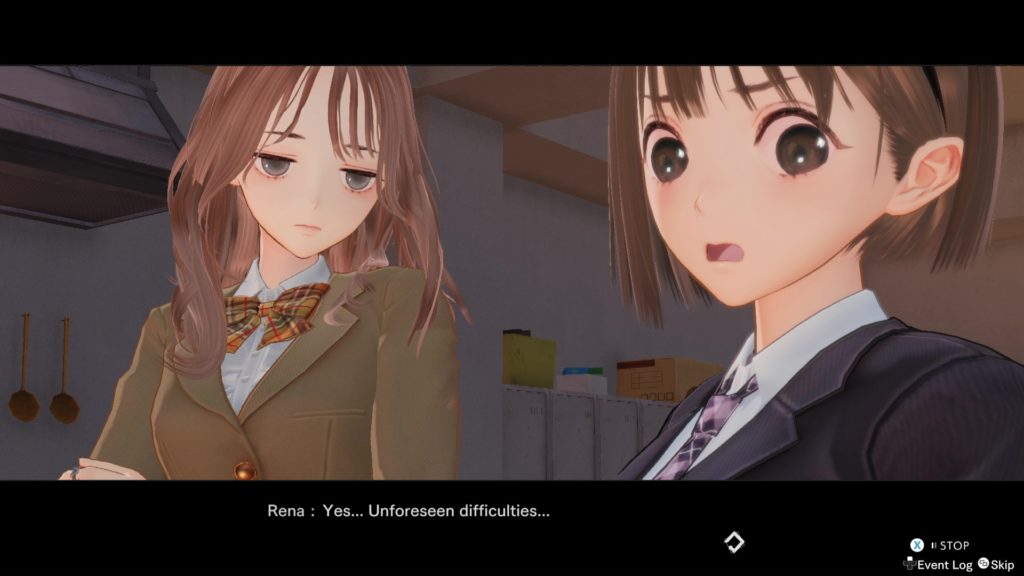
This being a Blue Reflection game, said relationships are, of course, key to character progression. In this instance, rather than completing requests directly leading to level ups as in the original game, here they award Talent Points. These can be spent on passive abilities that buff up stats, improve skills and suchlike, plus they also contribute to a meter that indicates the overall level of friendship between Ao and the cast member.
Interestingly, even the non-combat characters such as Yuki have a set of Talents to unlock; in these instances, their Talents buff up the whole party in various ways through their support, so they’re just as important to develop as the individual characters who are directly participating in combat.
Interacting with characters can be done face-to-face, but can also be accomplished using the “FreeSpace!” app on Ao’s phone; as is a popular narrative trope in anime and related media these days, it appears that said social media app is somehow the reason Ao was brought to the other world.
While the origins of FreeSpace! remain mysterious at the outset of the game — as does the identity of the mysterious helper on the platform known only as ReSource — the girls are quick to adapt to it as a means of communication, establishing the “Idle Idols” group chat as a means of conversing with one another from afar, and direct messaging one another when they have private things to share.
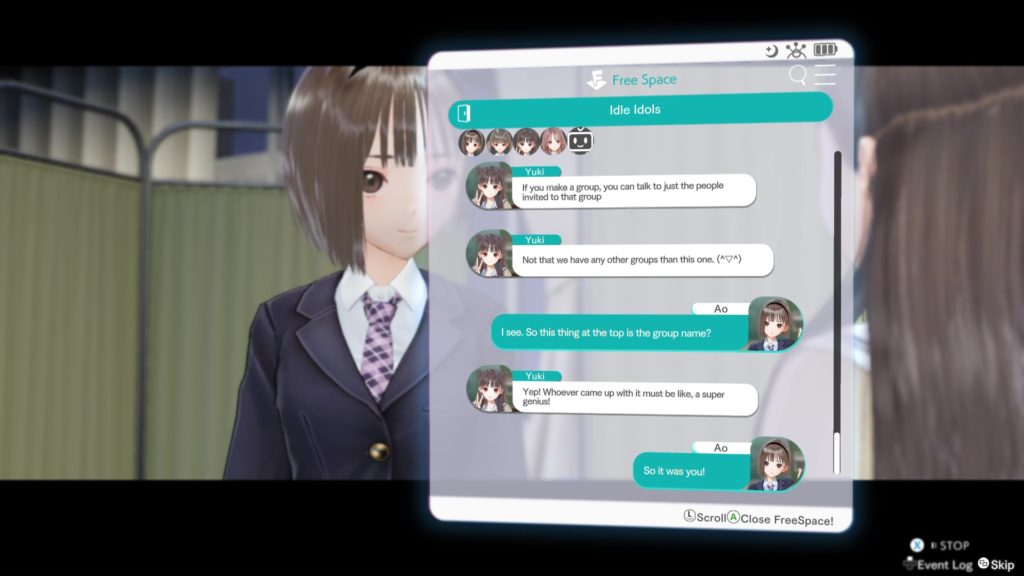
During FreeSpace conversations, you’ll often have the opportunity to choose how Ao responds. In the early hours of Blue Reflection: Second Light, it’s not clear if this has a direct impact on your relationship with the other character, but since in the original game the ways in which you interacted with your peers affected which equippable emotional Fragments you would be able to obtain from them, it’s likely that there is some relevance to these options in the long term — so be nice!
A nice touch about the school sequences in Blue Reflection: Second Light is that the whole school is now rendered as a single map, meaning you can do things like look through the windows from outside and see if anyone is hanging out in a particular room and transition from inside to outside with no load times. The characters will also seemingly wander around and do their own thing during downtime, too, which means they don’t just stand around waiting for Ao to come and bother them.
This makes it feel much more like you’re really living with these girls rather than simply using them as resources, and this feeling of “group bonding” is very important to the overall vibe of Blue Reflection: Second Light.
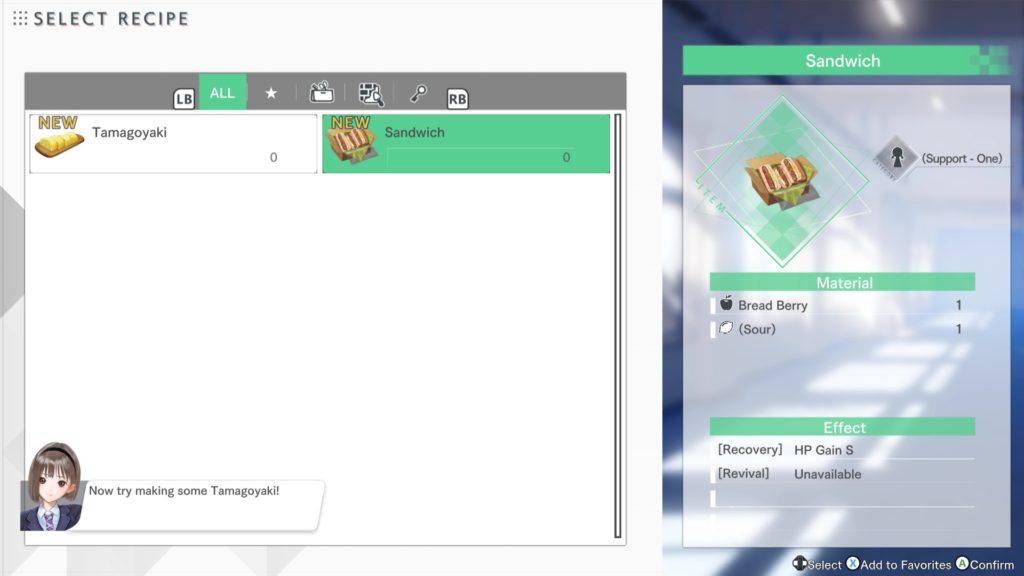
One of the most obvious ways in which the group dynamic is shown comes any time you choose to craft something. The crafting system isn’t quite as complex as that seen in the Atelier games, but it has taken a few influences from them and has a degree or two more depth than the one seen in the first Blue Reflection.
Recipes are acquired as the girls rediscover memories — it seems that having a revelation about one’s childhood often also helps you recall how to make a sandwich. By visiting the “work room” that the girls have set up in the school, you can cook food or create helpful items using the ingredients you’ve gathered from the Faraway — and rather than all crafted items having exactly the same effect, there’s a degree of variability introduced to the mix from how the game allows you to use categories of items rather than a specific item.
For example, when making the aforementioned sandwich, you need the specific “Bread Berry” item as the basis of the sandwich, but the other ingredient can be anything that includes the category “Sour”. By experimenting with different ingredients, you can potentially produce slightly different effects on your consumable items. There’s no worrying about quality levels and effect levels as in the more complex Atelier games, but it is a welcome improvement to the fairly simplistic crafting system from the first Blue Reflection, for sure.
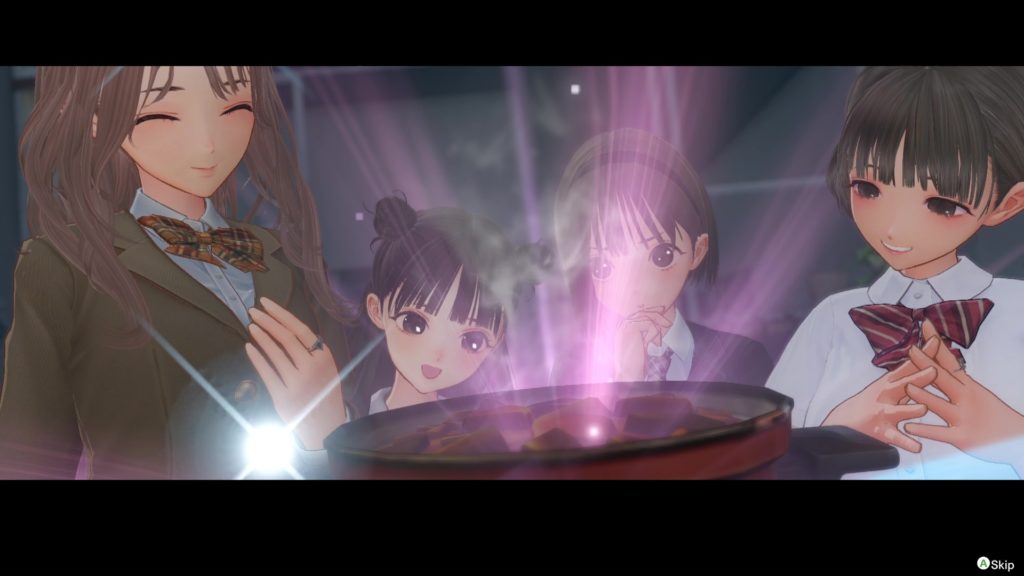
Once you’ve finished choosing ingredients, you get a delightful little cutscene of the girls working together to produce the item, and said scene takes into account what kind of item they’re making. If they’re making a consumable food item, you’ll see them cooking; make something eminently more practical and you’ll see them taking up their tools and working on the project together. There’s a really pleasant sense of everyone mucking in and getting involved, and little touches like this really help establish the ensemble cast as a coherent unit where everyone is relying on one another.
The same is true once you step outside of the safety of the school grounds and into the Faraway, too. The girls will converse with one another, comment on the things they find and talk about what they’re doing at any given moment.
In one particularly memorable instance, the first time you crawl under a low object — an action which carries with it an unavoidably provocative camera angle — Ao jokes that her friends shouldn’t look at her butt; while the rather strait-laced Rena doesn’t have much patience for this silliness, this comment is also clearly an opportunity for the player to feel like they’re in on the joke, too.
The Faraway itself is much more complex and interesting to explore than The Common from the first Blue Reflection game. While The Common was beautifully presented, its maps were small and the overall feel was that it was designed to be more “functional” than a place you would spend a lot of time exploring.
More often than not, you’d head in, achieve your objective and get straight back out again — this was perfectly fine given that the focus of the original Blue Reflection’s narrative was very much on the “real world”, but in Blue Reflection: Second Light, the more inherently exploratory nature of the story and setting means that it makes sense for the “dungeons” to be a lot more involved.
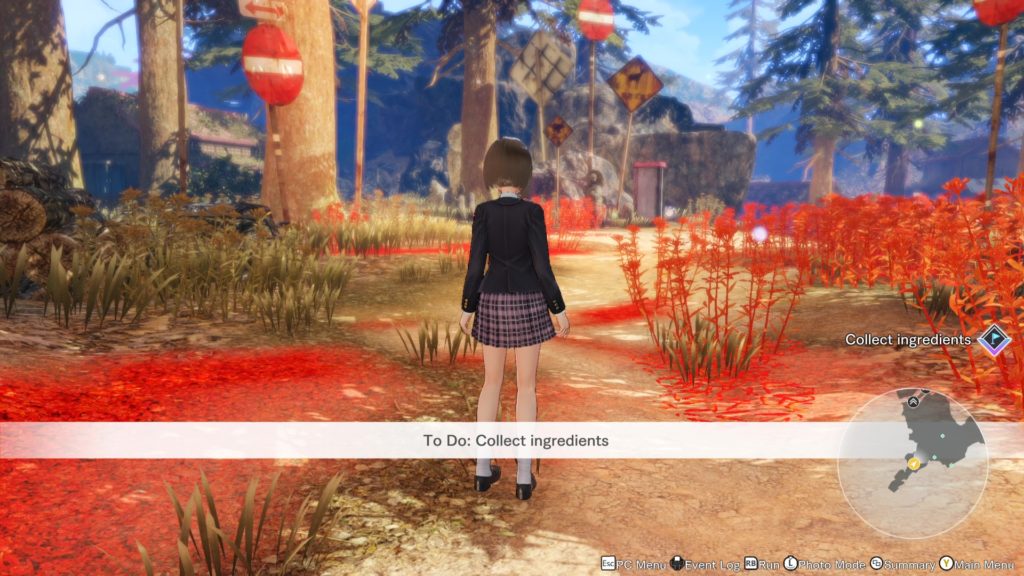
While not quite offering the huge open zones of Atelier Firis, Blue Reflection: Second Light does feature some pleasingly expansive environments with plenty of interactive elements. There are ladders you can climb, beams you can carefully tiptoe across, the aforementioned structures you can crawl beneath and sections where the girls need to work together to reach high or distant platforms.
To make things more interesting, occasionally you’ll be presented with “Stealth” sequences that require you to find your way around enemies rather than battling them directly. During these sections, you can activate a special vision mode that highlights enemies and their range of vision both on the main game screen and the minimap, so you can plan your route and time your movements accordingly.
Stealth sequences can easily be frustrating and feel out of place, but in Blue Reflection: Second Light they appear to be executed quite well, and generally seem to be more “puzzles” than action sequences. You’ll need to spot the key interactive elements you need to reach — a ladder, for example — and plan a route around the enemies in order to reach your destination. Plenty of helpful feedback is given so you’re never just stumbling around blindly wondering where you’re supposed to go, and the special vision mode is extremely useful.
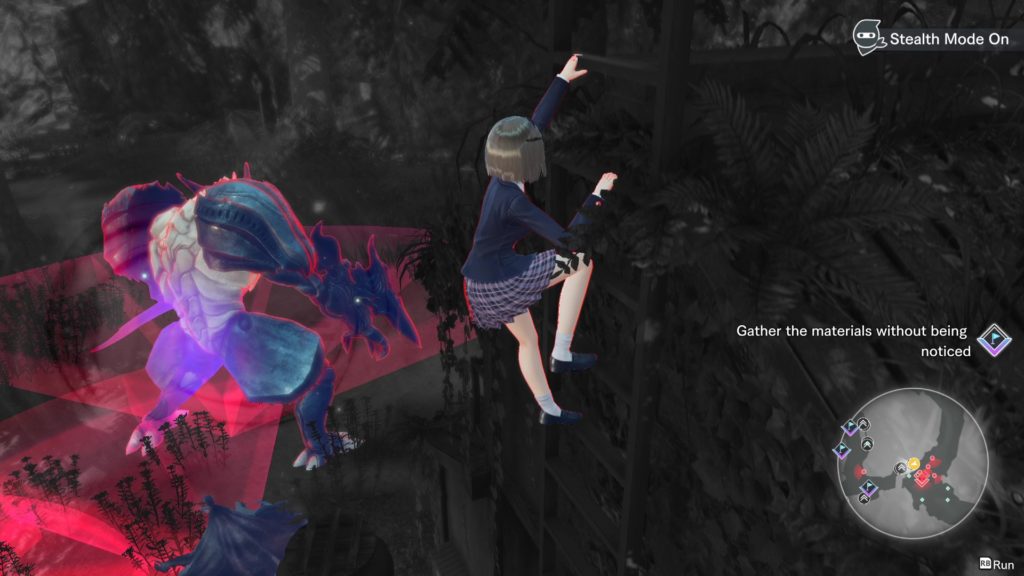
While you have to restart the stealth sequences if you fail them, running into monsters under normal circumstances will trigger the combat system. Like in Atelier (and indeed many modern RPGs), Blue Reflection: Second Light makes use of a symbol attack system, whereby if you hit an enemy with your weapon on the field screen you’ll begin combat with an advantage — usually in the form of Ao being react to immediately act as soon as battle begins.
Combat in Blue Reflection: Second Light is an interesting blend between real-time and turn-based. A time gauge in the corner of the screen indicates how much Ether each of the girls has charged up, and when this reaches at least 1,000 they can take an action. The interesting thing is that both the girls and the enemies can take their actions simultaneously, making for enjoyable situations such as defeating an enemy just as it’s closing in on one of your party members, ready to strike.
Unleashing skills in succession adds to a combo meter, which increases the overall damage output of the party. Each successful skill also increases the rate at which a character accumulates Ether, and every few increases in speed they shift up a “Gear”.
Each increase in Gear allows them to stock up to an additional 1,000 points of Ether — though it charges at the same rate, so accumulating more takes longer — and consequently make use of multiple skills in succession. And upon reaching third Gear, the character will transform into their full Reflector form; rather than simply using their weapon, they will change their costume and increase their abilities significantly.
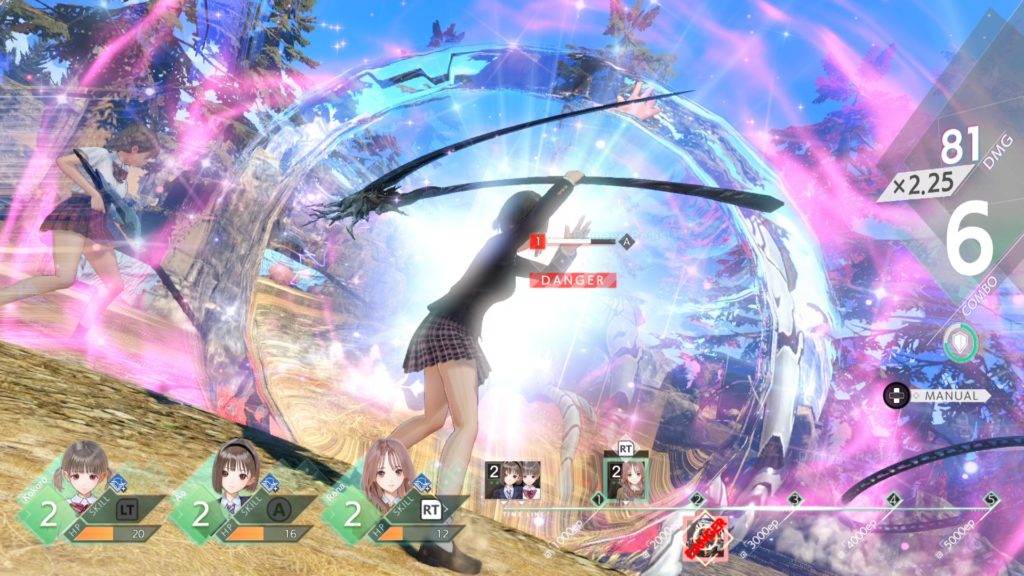
By default, you only trigger Ao’s skills with the A button, but those who prefer to take complete control of the battle can switch the game to manual mode; here, Kokoro and Rena’s skills can be triggered with the left and right triggers respectively. Characters learn new skills as they level up — which occurs through a conventional experience points system this time around — and shifting into higher Gears allows them to make use of more effective versions of their existing skills.
Some of these cost more Ether, though, which makes for some interesting decision-making: when in second Gear with a maximum of 2,000 Ether, for example, is it worth using a more powerful 1,500 Ether skill, or two 1,000 Ether skills?
The combat is simple, satisfying and fast-paced, but it’s clear there will be plenty of tactical depth gradually introduced through the various skills that the girls are able to use. Early in the game you’re introduced to stat-buffing items, support skills and the ability to protect your combo from powerful enemy attacks — doubtless there will be plenty more things to enjoy as the game progresses.
Finally, it wouldn’t do to close off this preview without saying how absolutely beautiful Blue Reflection: Second Light looks. The original game was already quite a looker with its wonderfully detailed backdrops, splendid use of colour and excellent cinematography in its cutscenes, but Blue Reflection: Second Light really takes things to another level.
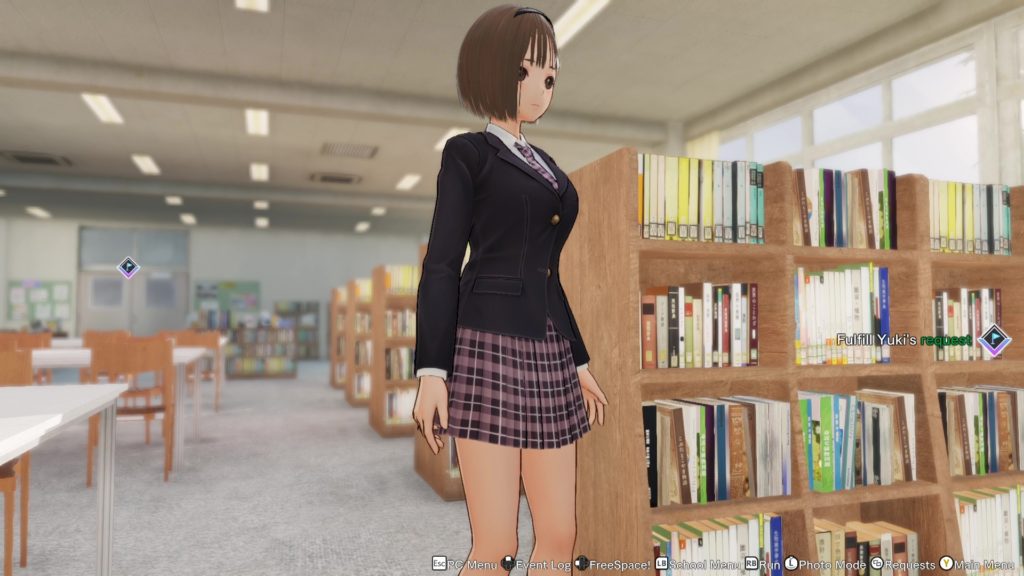
The characters are much more expressive, the backgrounds are, once again, full of detail, the lighting is spectacular and the environments are interesting and varied to explore. And the music is, once again, absolutely astonishing, combining atmospheric plinky-plonky piano pieces during calm moments with thrashing electronic beats when things get intense. And longstanding fans will be pleased to hear a number of iconic themes return alongside all the new tracks.
Honestly, even after just a few hours with the game I could probably go on for a lot longer, but I’ll restrain myself. Suffice to say for now that we’re looking at a very special game here; it’s emotionally engaging, mechanically solid and beautifully presented — and I can’t wait to see how the story continues.
Blue Reflection: Second Light will be available for PC, PS4 and Nintendo Switch on November 9, 2021. Thanks to Nathan at Koei Tecmo for the preview code — check out the lovely limited editions they’ve got on offer!
Join The Discussion
Rice Digital Discord
Rice Digital Twitter
Rice Digital Facebook
Or write us a letter for the Rice Digital Friday Letters Page by clicking here!
Disclosure: Some links in this article may be affiliate links, which means we may earn a small commission if you make a purchase after clicking on them. This is at no additional cost to you and helps support Rice Digital!
- Letter from the Editor: passing the torch - June 30, 2023
- Super Woden GP 2 is looking promising - June 30, 2023
- Inti Creates is making a 32 bit-style Love Live action platformer - June 26, 2023




